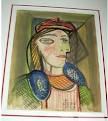Blog Archives
Fakes on the Wall
 The art most commonly faked are prints supposedly made by Chagall, Miro, Dali, and above all, Picasso. There are many, many more fakes out there than there are authentic works of art, and many of those fakes are accompanied by fancy Certificates of Authenticity—also faked, of course. So if you’ve inherited a print signed by one of these artists, assume you have a fake until you can authenticate it.
The art most commonly faked are prints supposedly made by Chagall, Miro, Dali, and above all, Picasso. There are many, many more fakes out there than there are authentic works of art, and many of those fakes are accompanied by fancy Certificates of Authenticity—also faked, of course. So if you’ve inherited a print signed by one of these artists, assume you have a fake until you can authenticate it. 
How to authenticate something? You need a certified expert to do that. Ask an art museum or large auction house in your city for recommendations, or do some online research. Check credentials. Just because someone says he is a member of the IFAA (International Fine Art Appraisers) or some such professional organization doesn’t mean he really is. A quick phone call to the organization’s headquarters can make sure. In general, local is better–you don’t have to mail your item. Expect to pay at least $100, although some services do not charge when they don’t have to do any research–when the item is so obviously a fake that they can tell at a glance.
Here’s one place you can start for free: the Chicago Appraisers Association. Send them a good photo of your piece in the mail and they will tell you, for free, whether it warrants further research or not. If so, they will then tell you their fee, and you can decide how to proceed. If not, you know you have a fake and can proudly display it on your own wall and let your friends think it’s original. But don’t try to sell it. Their address and further information can be found at http://www.chicagoappraisers.com.